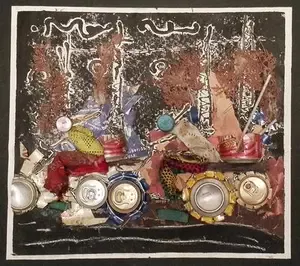Search this site ...
Contemporary African Artists
In the last decade, there has been a radical and overwhelming upsurge in the number of artists from the African continent who are producing extraordinary and ground breaking work in all fields of contemporary art.
In some genres like upcycled and reconstituted pieces, they are absolutely leading the world stage and blowing it wide open with their inventiveness, creativity and ingenuity.
Gresham Tapiwa Nyaude is an excellent example of a young artist who has shot into the international limelight, winning top awards and whose pieces feature in the Smithsonian National Museum of African Art, Washington and the Rubell family collection to name just a few.
His satirical paintings aim to lend hope and ignite political resistance at the same time... it combines figuration, abstraction and hallucination to create its unique, high impact brand of art.
Historically, shows like 'Africa Remix' classified contemporary artwork on the basis of the artist's nationality and massed them under a very large 'African' umbrella.
The show served a purpose in gaining exposure for many contemporary African artists that may not otherwise have had their works exhibited at an international level but there is occasion now for a change in the way African art is exhibited at home and further afield.
Presently, contemporary African artists themselves have a strong conviction about their work, they know that it has validity and contributes to a contemporary African discourse and they are taking a more active role in developing and defining exactly what is Contemporary African art.
But they cannot do it alone and African governments and institutions must realise that culture and development are inseparable; funds need to be allocated for the advancement of art of all forms. Art and culture have to be promoted within society until they collectively become a matter of national pride and art again takes its important place within the community as it did before colonialism arrived on the continent.
True contemporary African artists operate outside the rationale of international art and reflect their own underlying principles.
Established contemporary artists from Africa
The following artists are very well established and have made substantial impact on the art world both in Africa and internationally for a considerable length of time:
- Frederic Bouabre, Ivory Coast b 1923
- Ablade Glover, b 1934, Ghana
- Esther Mahlangu, South Africa b 1935
- Cyprien Tokoudagba, Benin b 1939
- Georges Adeagbo, Benin b 1942
- Henry Tayali, Zambia, b 1943
- El Anatsui, Ghana b 1944
- Rachid Koraichi, Algeria b 1947
- Bodys Isek Kingelez, DRC b 1948
- Hassan Musa, Sudan, b 1951
- Marlene Dumas, South Africa b 1953
- Abdoulaye Konate, Mali b 1953
- William Kentridge, South Africa b 1955
- Cherie Cherin, DRC b 1955
- Willie Bester, South Africa b 1956
- Owusu-Ankomah, Ghana b 1956
- Samba Cherie, DRC b 1956
- Julian Singozen, Benin b 1957
- Sokari Douglas Camp, Nigeria/UK b 1958
- Richard Onyango, Nigeria b 1960
- Yinka Shonibare, UK/Nigeria b 1962
- Romauld Hazoume, Benin b 1962
- Sandile Zulu, South Africa b 1962
- Ghada Amer, Egypt b 1963
- Barthelemy Toguo, Togo b 1967
- Pascale Marthine Tayou, Cameroon b 1967
- Kendall Geers, South Africa b 1968
- Soly Cisse, Senegal b 1969
- Julie Mehretu, Ethiopia/NY b 1970
- Abu-Bakkar Mansaray, Sierra Leone b 1970
- Wengechi Mutu, Kenya/USA b 1972
- Claudette Schreuders, South Africa b 1973
- Tracy Rose, South Africa b 1974
- Aida Muluneh, Ethiopia, b 1974
- Peju Alatise, Nigeria b 1975
- Goncalo Mabunda, Mozambique, b 1975
- Robin Rhode, South Africa/Berlin b 1976
One of the biggest dilemmas facing contemporary African artists today is racial prejudice which is a spillover from the same attitude that has existed throughout the last century. The expectation is that African artists should be unaffected by global influences and to be seen as 'authentic' their art should remain tribally based, instinctive and primitive.
This however shackles contemporary African artists to their bedposts but a few like Gerard Quenam, b 1971, Benin have managed to express their tribalism in a very contemporary conceptual manner that pays homage to his past but makes it exciting and relevant to 'now'.
 Gerard Quenum, 'La bonne bergère' (The Good Shepherdess), 2012. Wood, metal, beads, rope and plastic doll, October Gallery
Gerard Quenum, 'La bonne bergère' (The Good Shepherdess), 2012. Wood, metal, beads, rope and plastic doll, October GalleryThere is much to be learnt about the culture of African societies and their traditional visual language; we have not even touched the surface in understanding its complexities and nuances. Some of it that intricacy they may not even want to divulge, for it has its own reverent place and being declared an art piece may be entirely inappropriate and demeaning to what it was created for.
This is however a domain that requires a lot of money, intelligent initiatives, national discourse and continental collaboration so that African contemporary art can move beyond individual gain and collectively grow in substance.
Now is the time to invest in effort to develop associations with some of the larger museums in Europe and the Americas who would benefit hugely from on-the-ground transference of ideas rather than just reinventing their archival artifacts and exhibiting them alongside their choice of international African artists, some who have had very little to do with the continent at all.
Assistance is definitely required but not in a paternalistic fashion and it is up to the African component to have enough self confidence about what they have to offer and showcase to ensure this does not occur.
Wangechi Mutu, b 1972, Kenya
Wangechi Mutu has to be one of the most exciting artists in the world art arena right now and is for me, the epitome of a thoroughly modern, global Contemporary African Artist. The Deutsche Guggenheim saw fit to elect her 'Artist of the Year, 2010', a decision that guaranteed her long-term impetus to her career.
Wangechi Mutu was born in Kenya, schooled in Wales, and presently resides in New York. She is not so concerned with reflecting her original cultural identity as she is with how her life will evolve being a member of the 'Alienationals'; permanent travelers whose cultural identity has become a hybrid creation.
 Intertwined
IntertwinedHer installation pieces suggest her own little piece of heaven, a room where she has ensconced herself just like many immigrants whose dreams and longings are echoed in the space they inhabit, creating some stability in their itinerant world. Her evocative, hugely detailed collaged works are charged with her energy due to the very individual thoughts and time consuming processes that produce the final result.
Her work is a reflection of firstly, her primary situation of existence and secondly, her heritage which one can locate in the use of animal masks, transcendence of beings, reference to traditional customs and primal habitats.
Julian Singozan b 1957, Benin
Julian Singozan is an extraordinarily optimistic person whose work could be shrouded in bitterness and brutality considering his chosen subject matter.
Instead it is uplifting and meaningful. And it is also beautiful; the use of color is specific and dynamic and his drawing is skillfully and intricately executed. The importance of his work lies in the insight of a contemporary African artist's approach to painting a narrative piece that has spiritual, historical and aesthetic components.
 Detail, Gates of Return, Victoria and Albert Museum, 2007
Detail, Gates of Return, Victoria and Albert Museum, 2007Julien studied architecture in Tashkent and then left for Paris where he took up drawing and painting. He represents pictorially historical events of his people in a well-defined technical tradition but infuses his work with a human and spiritual content that is reminiscent of his culture.









New! Comments
Have your say about what you just read! Leave me a comment in the box below.